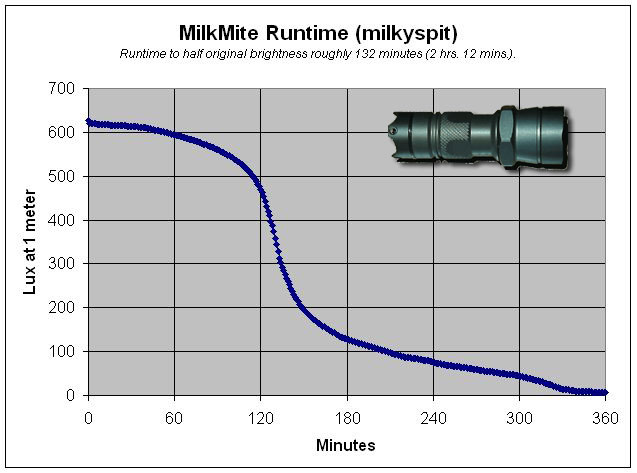Chop, I think I'm on record elsewhere on CPF as saying I
hate the stock circuit! /ubbthreads/images/graemlins/icon15.gif I haven't posted very many things that strongly. However, it is a fun circuit to play with... I actually made a nifty "Milky Candle Shorty" by cobbling together some PVC pipe sections, a flame-shaped plastic cap from a dollar store Christmas candle, a 10mm LED, and the stock Q3 circuit. I swapped out the sense resistor to set the circuit for a maximal current flow of 40mA... now the little guy runs nicely off a single 123 cell for maybe 40 hours in regulation, then declining light for another dozen hours or so! /ubbthreads/images/graemlins/grin.gif
Pulses of high current (as this circuit does) present a tradeoff: one the one hand they can keep the Luxeon closer to its binned color since each pulse drives the spec'd amount of current through it; but on the other hand they're generally not as efficient as a well-designed constant current circuit. At least that's my understanding! /ubbthreads/images/graemlins/ooo.gif The trouble with the Q3 circuit is that it isn't even regulated... since the "off" duration increases as the 123 cell drains, the output gets dimmer! /ubbthreads/images/graemlins/rant.gif So basically, it offers all the downside of a high output regulator (short battery life and sudden shutdown of the light) with none of the upside (the pulsing results in effective output that's only a fraction as bright as a REAL constant current 950mA output would). /ubbthreads/images/graemlins/frown.gif
IMHO the Dorcy 1AAA LED circuit is the perfect complement to the stock Q3 circuit. Like stock, the Dorcy board is a boost circuit, not truly a regulator; however, it generates a continuous flow of output current instead of pulses... it's actually very much like dat2zip's various MadMax boards, except that the Dorcy doesn't offer as much output current as a MM+ would. Think of it a little like a ghetto MM lite! /ubbthreads/images/graemlins/grin.gif
Compated with the stock circuit, the Dorcy will deliver something on the order of TWICE the duration of bright output, plus it degrades far more gracefully... in fact, while measuring for a detailed runtime graph one evening, I fell asleep, only to wake up and find that the test light was still operational on its single 123 cell
8 hours after I'd turned it on. The output was definitely nowhere near what I'd call bright, but surprisingly (at least to me!), it was still bright enough to walk around my house without tripping or stepping on anything... and that's no easy feat since my kids usually have toys scattered in pretty much every room! /ubbthreads/images/graemlins/faint.gif Hmm... here's a runtime graph from my
MilkMite mod, which should also apply to the Q3 when a Dorcy board is installed...

As far as lux readings, lots of things can affect those. What most folks forget (even most flashaholics!) is that the eyes do NOT perceive brightness in linear fashion, but rather in logarithmic fashion. In more concrete terms, that means a light pumping out 1200 lux would look
only 30% brighter than one only generating 600 lux. Meanwhile, though, it cuts runtime in HALF to double that lux reading and get the extra 30% brightness... or maybe LESS than half! That's because the battery's stored capacity drops when higher current flow demands are placed on it, and the LED itself generates light less efficiently as its internal temperature rises higher and higher. Soooooo... strange as it may seem, that 1300 lux monster might only look marginally brighter than the 700 lux Q3.
But wait, there's more! (Sounds like a Ginsu knife commercial!) /ubbthreads/images/graemlins/yellowlaugh.gif Since lux measures beam intensity rather than total output, lots of other things can influence it. Here's a partial list... a smooth reflector reads higher lux than an orange peel one, even if the total output of both is identical... a reflector that more aggressively focuses into a narrow beam will have a higher lux reading... a UCL will give a higher lux reading than a polycarbonate lens, both because it passes more light and because the plastic itself probably diffuses the light passing through it a teensy bit... the list goes on and on. Also, the same light will give a higher lux reading when it's first turned of than it will later, when the emitter's grown warmer! There are probably lots more things to take into account.
Ufokillerz and I compared a bunch of stock SureFire L4 flashlights about a year ago... the dimmest read around 600 lux, and I think the highest might have approached 1000 lux! But the bright one in reality only looked a little brighter... the difference was clearest when holding one L4 in each hand and alternately turning each one on and off. We've gotta make sure we keep the real world goals in sight (no pun intended), and don't get caught up in the numbers! /ubbthreads/images/graemlins/icon15.gif
Jchock, you ain't no bonehead, my friend. /ubbthreads/images/graemlins/wink.gif I'm not so sure it's easy to quantify what each change does for lux in an absolute sense, because everything will vary from light to light, part to part. However, if you're looking for biggest bang for the buck ranked roughly from best to worst, that we can probably do! I'd make one list that doesn't affect battery life, and a second list that does. Here are some examples that maybe others could build on...
Lux-Boosting Mods that Don't Affect Battery Life
1. Switch to a smooth reflector
2. Install an emitter with a higher-binned flux (meaning it'll be brighter with the same input current)
3. Replace the polycarbonate lens with a UCL (an ultra clear glass lens... lets more light pass through)
4. Improve the heatsinking to keep the LED cooler
Lux-Boosting Mods that DO Affect Battery Life
1. Install a more efficient boost circuit!
2. Increase the maximum current flow setting, up to the limits of the battery (and even then, keep going with a Li-ion rechargeable instead of a single-use 123 cell)


